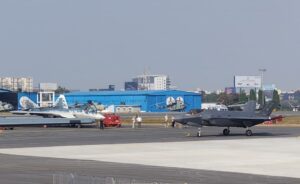 |
| F-35 ans Su-57 on Tarmac during Aero India 2025 |
The F-35 stealth fighter was offered to India by US President Donald Trump on February 14. Russia has also extended an offer to India for its Su-57 5th Generation fighter. This offer is in addition to the Su-75 light stealth fighter, which Russia offered to India a few years back. The recently concluded Aero India 2025 exhibit marked the first time in history that F-35 and Su-57 fighter aircraft were in attendance.
For more than two decades, India has been attempting the acquisition of one hundred fourteen fourth-generation fighters. Nevertheless, the situation has since evolved, and China, India’s arch-rival, has a number of 5th-generation aircraft models in operation and in the pipeline. Pakistan, a long-standing rival of India, has also disclosed its intention to acquire J-35 stealth fighters from China.
India is in the process of developing its own fifth-generation fighter, the AMCA (Advanced Medium Combat Aircraft), and may opt to prioritize indigenous solutions over the import of costly foreign platforms. Along with an invitation to participate in the Global Combat Air Program (GCAP) from the UK-Japan-Italy consortium, India has reportedly received offers from Germany and Spain to join their 6th Generation Future Combat Air System (FCAS) program.
The Su-57 may be appealing to India if it prioritizes cost-effectiveness and air superiority. For the same capital investment, India could acquire a greater number of Su-57s than F-35s, and it would also benefit from reduced operating expenses. India may be offered local licensed production of the Su-57 by Russia, in a manner similar to the Su-30MKI production by Hindustan Aeronautics Limited (HAL).
In the past, the Indian Air Force has not always had a positive experience with Russian imports, particularly in terms of after-sales support and maintainability. Nevertheless, Russia has been providing India with its state-of-the-art aircraft, which have performed exceptionally well during the conflicts.
The F-35 is a better choice for India if it is interested in network-centric warfare, advanced stealth, and a stronger relationship with the West. The procurement of the F-35 may be complicated by India’s current inventory of Russian equipment, including the S-400 air defense system. Throughout history, India has depended on Russian (and Soviet) military hardware, such as fighters like the Su-30MKI and MiG-29. Significant modifications to infrastructure, training, and maintenance would be necessary to transition to a US-made platform such as the F-35. The United States is guarded in its sharing of sensitive technology, even with close allies, as the F-35 is one of the most advanced fighters in the world. India’s “Make in India” initiative, which mandates technology transfer as a component of defense contracts, may prove to be an obstacle. Vikram Misri, the Indian Foreign Secretary, emphasizes that a formal process must be followed for military procurement and that it has not yet commenced.
The F-35 is costly, with a price tag of $80–100 million per unit. However, it is equipped with global logistics support. The Su-57 is more cost-effective, costing approximately $50 million; however, Russia’s reliability and maintenance support may be unpredictable. At the same time, the United States has a history of denying spares and support for its export equipment and enacting sanctions.
In terms of warfare, the Su-57 will be more advantageous for India when it confronts its smaller neighbor, Pakistan, due to the fact that flight duration’s are significantly shorter and there is a high likelihood of a dogfight. It is not anticipated that Pakistani J-35s will be technologically advanced due to cost considerations and dependence on Chinese electronics. Concurrently, both the F-35 and Su-57 aircraft would prove advantageous in the context of the conflict with China. Although both aircraft are capable of launching long-range weapons, the Su-57 has an advantage. The US might not authorize India to use the F-35 if it fears that its relations might escalate with China. We have seen this in Ukraine. On flights over Tibet’s rarefied atmosphere, Chinese stealth fighters are expected to lag behind Russian and US ones. The US and Russian aircraft are anticipated to be able to navigate the Tibetan airspace more effectively as a result of their potent engines.
India may also evaluate alternative options, such as the Dassault Rafale and Eurofighter Typhoon, or continue to develop its own 5th-generation AMCA to meet its immediate requirements.
Official Website of Youtube Channel – Altitude Addicts

